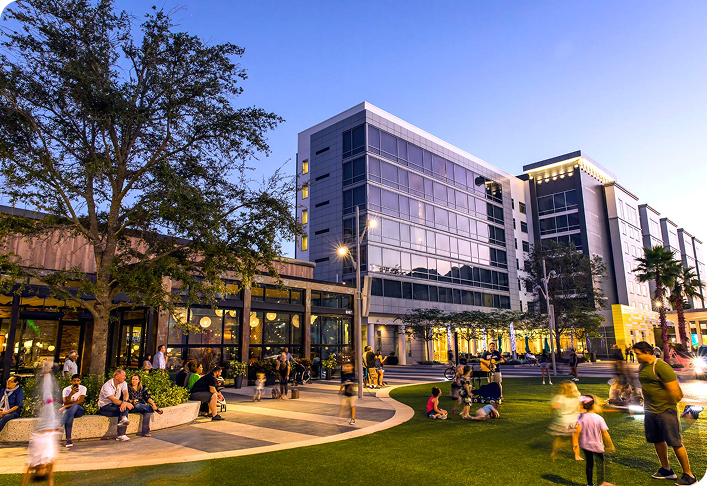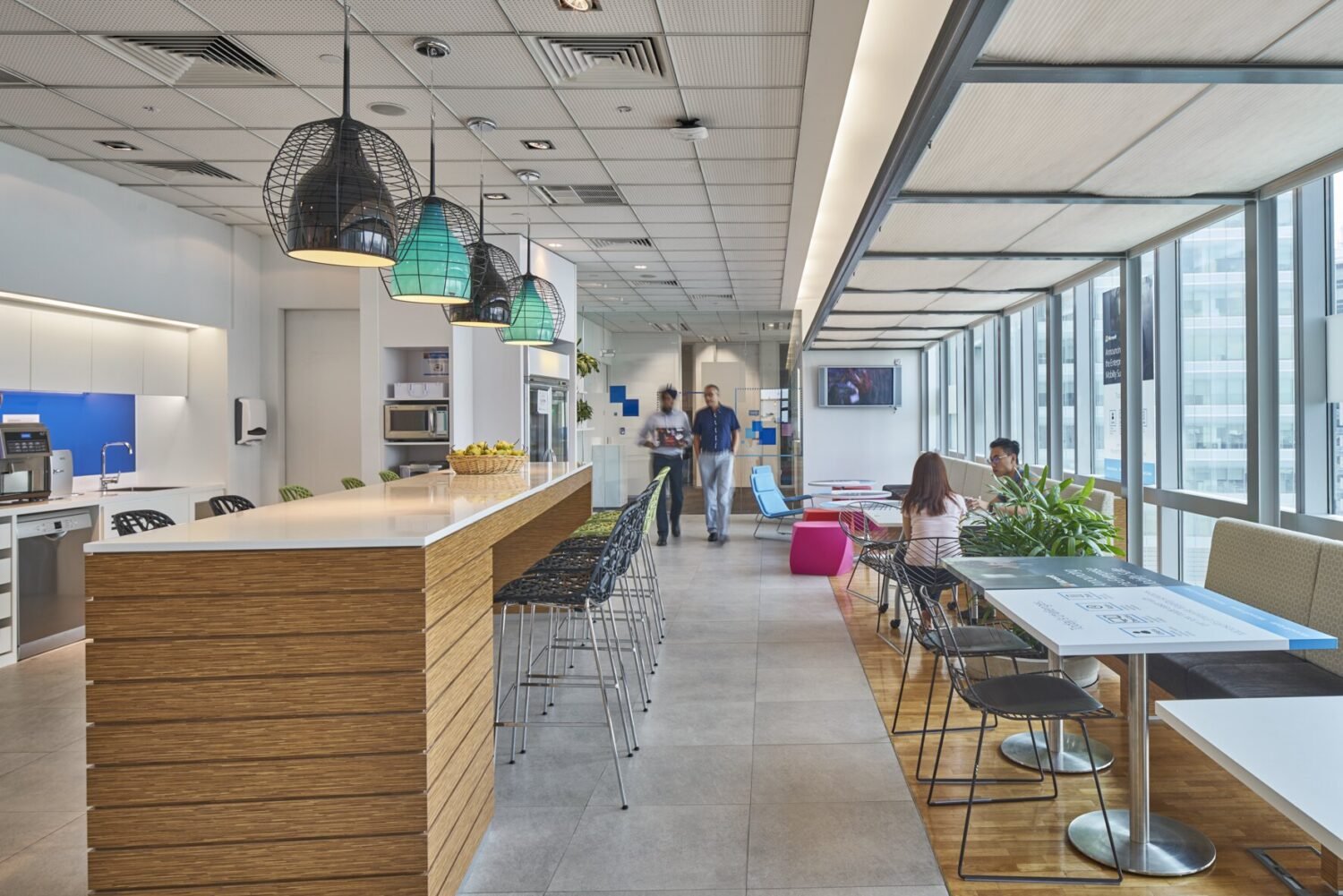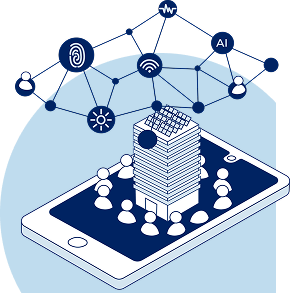Biometric Wellness Optimization & AI-Driven Environments: Landlord of the future Part 1
The rapid advancement of AI and smart building technologies are reshaping the way that landlords connect with tenants and their staff, creating more responsive and adaptive spaces. But in this evolving landscape, simply having a tenant app or outfitting a building with 'smart' features like advanced visitor entry and smart elevators is no longer sufficient.
Based on our work with real estate developers at the mixed-use and district-scale, UrbanSense recognizes the potential for landlords to deliver experiences to tenants that have a much bigger impact than any single tenant could achieve alone.
Wellness Is the New Amenity
For landlords and developers who prioritize leasing spaces and helping tenants succeed once they are on-site, integrating AI-driven systems that deliver personalized environments for both tenants and their staff is now a game-changer. Today's tenants seek more than just smart thermostats and high-speed Wi-Fi; they desire buildings that actively support the physical, mental, and emotional well-being of their on-site staff—thereby incentivizing people to not only come into the office, but prefer the office environment to working from home.

Case study spotlight
Water Street Digital Master Plan
UrbanSense's digital master planning work with Water Street Tampa exemplifies this shift toward wellness-centered environments. Rather than treating individual buildings as isolated entities, we developed a plan for integrated digital infrastructure that spans the entire mixed-use district, from residential buildings to the Amalie Arena. This district-scale approach to technology enables property managers to coordinate environmental conditions across multiple buildings, creating wellness zones that extend from office spaces to retail areas and public gathering spaces. The vision of our plan was a seamless wellness ecosystem where occupants experience consistent, optimized environments as they move throughout their day—something no single tenant could achieve within their individual leased space. Since our work, Water Street Tampa became the first neighborhood in North America to achieve a WELL Gold certification by the International WELL Building Institute, an organization that recognizes neighborhoods that promote health and well-being across all aspects of community life.
Biophilic Design as a Core Wellness Strategy
In parallel with biometric and AI-driven innovations, biophilic design is becoming a foundational element of wellness-centered workplaces. By integrating natural elements like daylight, greenery, water features, natural materials, and organic forms into the built environment, landlords can significantly enhance occupants’ mental and physical well-being. Studies show that exposure to biophilic environments leads to reduced stress, improved cognitive function, and increased productivity, making it a critical differentiator in today’s hybrid work era. Beyond aesthetics, biophilic design reinforces the human-nature connection in indoor settings, which is especially powerful when combined with environmental sensors and AI systems that adjust conditions like light and airflow in real time.
What Is Biometric Wellness Optimization?
Biometric wellness optimization, or using real-time biological data to monitor and enhance individual and group performance, isn’t a new idea. The first version of biometric monitors in the form of wearable tech - measuring everything from heart rate, blood oxygen, and glucose to sleep quality - is growing. We anticipate that the next generation of this personal tech will be integrated with the built environment, for example:
Heart rate variability sensors will detect stress levels and automatically trigger calming environmental changes like softer lighting or stress-reducing soundscapes
Air quality sensors measuring CO2, VOCs, and particulate matter will adjust ventilation when biometric indicators show cognitive fatigue
Temperature and humidity sensors will create micro-climates optimized for individual wellness zones based on occupancy patterns and biometric feedback

Case study spotlight
Lake Nona Digital Master Plan & Product Prototyping
UrbanSense’s Digital Master Plan for Lake Nona demonstrates how biometric integration could work at the community scale. Working with this health and wellness-focused development, UrbanSense prioritized initiatives such as a comprehensive sensor network that monitors environmental conditions across residential, commercial, and recreational spaces.
What makes the output of our technology planning process particularly powerful is the integration between indoor and outdoor environments—biometric data from fitness trackers and health monitoring devices informs decisions about park lighting, walking path maintenance, and even the timing of community wellness events. This creates a 24/7 wellness ecosystem that extends far beyond any individual building's capabilities.
The "Landlord Advantage"
Landlords are uniquely positioned to help tenants create spaces that measurably improve cognitive performance and well-being, giving companies concrete ROI data on employee productivity gains. Unlike individual tenants, landlords oversee entire properties—or even portfolios—giving them unparalleled control over the design, operation, and optimization of these spaces.
What tenants can't replicate on their own is the scale and integration that landlords uniquely control. Individual companies might deploy air quality monitors in meeting rooms, but landlords can create building-wide wellness ecosystems that respond to collective biometric data from hundreds or thousands of occupants simultaneously.
The most forward-thinking landlords are essentially becoming "wellness infrastructure providers" - offering environments that demonstrably improve human performance in ways that home offices or traditional buildings simply cannot match:
Landlords control building-scale infrastructure: Unlike individual tenants, landlords can deploy comprehensive sensor networks throughout entire buildings - monitoring air quality, lighting, temperature, humidity, noise levels, and even electromagnetic fields across all spaces simultaneously. This creates a unified wellness ecosystem where environmental conditions can be optimized automatically based on real-time biometric feedback from occupants.
Landlords can directly integrate with tenant wearables: The most innovative landlords are partnering with tenant companies to integrate building systems with employee wearables (Fitbit, Apple Watch, Strava, etc.) to create responsive environments.
Landlords manage real-time environmental response: Buildings equipped with AI can adjust lighting, air filtration, and acoustics based on real-time biometrics.
This innovative approach offers landlords a powerful edge—creating healthier, more responsive spaces that go beyond traditional tenant solutions, fostering well-being and satisfaction.
Case study spotlight
Biodiversity through Green Infrastructure
UrbanSense is partnering with New York City Bird Alliance to launch a new Biodiversity District. This initiative, which brings together organizations to coordinate green spaces in support of native habitat corridors, can showcase how environmental wellness extends beyond traditional building metrics. Clinical studies have shown that urban biodiversity positively impacts human health by reducing stress, improving mood, and supporting immune system regulation.
Access to green spaces with diverse flora and fauna has been linked to lower cardiovascular disease markers, reduced cortisol levels, and improved respiratory health. Working with property developers in New York, UrbanSense is supporting the monitoring of not just air quality and temperature, but also, through this initiative, biodiversity indicators like bird activity, plant health, and urban ecosystem vitality in support of native plant and animal species corridors.
These environmental wellness metrics can become powerful leasing tools—prospective tenants can see concrete data showing how their building contributes to both employee wellness and environmental sustainability. Companies increasingly view biophilic design and ecological integration as essential workplace features, potentially making buildings with verified biodiversity metrics significantly more attractive in competitive leasing markets.
Image © New York City Bird Alliance
By harnessing building-wide biometric data and smart infrastructure, landlords can unlock a range of benefits that surpass traditional amenities—creating healthier environments and driving better commercial results. Some of these advantages include:
Stronger Tenant Retention & Attraction
Wellness-focused spaces give landlords a competitive edge as companies prioritize employee well-being in leasing decisions.Quantifiable Health & Productivity ROI
Provide tenants with measurable improvements in focus, stress levels, and performance—supported by real-time building data. Companies using building-integrated biometric wellness report clear productivity gains and reduced stress levels that can be quantified through continuous monitoring. Landlords can offer tenants concrete data showing how their building environment improves employee performance metrics.Building-Wide Health Intelligence
Gain macro-level insights into occupant wellness trends to continuously optimize spaces and improve tenant satisfaction. Unlike individual wellness programs, building-integrated systems provide macro-views of organizational health, identifying high-performing environmental conditions and areas for improvement across entire tenant populations.Premium Positioning in the Market
Differentiate your building with cutting-edge, health-optimized environments—creating edge that’s difficult to replicate. As of 2025, employee wellness has become a primary factor in office selection, with companies specifically seeking spaces that demonstrate measurable health benefits. Research shows companies see $3.27 return on wellness investments through reduced healthcare costs alone.Proactive Risk Prevention
Predict and prevent issues like burnout or indoor air fatigue through biometric trends and adaptive environmental controls. Advanced biometric monitoring can predict health risks before they become problems - identifying patterns like poor sleep quality, elevated stress, or declining physical activity that affect workplace performance. Landlords can proactively adjust building conditions to prevent issues rather than react to them.

Industry Examples: Wellness & Engagement Innovation
Microsoft, Frasers Tower, Singapore
Microsoft's regional headquarters features 179 Bluetooth beacons and 900 sensors monitoring lighting, air quality, and temperature, generating 2,100 data points connected to Azure. This system optimizes space, lighting, and HVAC, with sensors tracking CO₂, noise, and energy use—achieving up to 25% energy savings, as seen at their Redmond campus.
Amazon's "Dragonfly" app allows employees to send safety and wellness suggestions via their devices. Over 130,000 employees used it in 2024, resulting in improvements such as repositioned scanners and laser sensors for forklift safety.
Since 2010, Google has operated Wellness Centers offering healthcare, mental health, and physical therapy services. Tens of thousands of employees across the US have utilized these facilities, emphasizing corporate wellness as a core value.
From Smart Buildings to Strategic Ecosystems
AI and new tech are revolutionizing the way investors make decisions. Today’s leading landlords are no longer just providers of space—they're stewards of employee health, energy efficiency, and workplace performance. But wellness is just the beginning.
To truly evolve into the landlord of the future, developers must understand not only how their buildings operate, but how people connect within them. In our next installment, we will explain how patterns of collaboration, movement, and proximity can reveal powerful insights—not just for improving layouts, but for curating communities within buildings.
discover more of Our Services

Digital master planning
Tactical plans for digital investments in public spaces, from infrastructure to user applications.

Community engagement
In-depth user research, workshops, and surveys to co-create meaningful, user-driven solutions.

Portfolio Scaling
Expansion of successful technology deployments across a broader portfolio, including across agencies, districts and municipalities.

